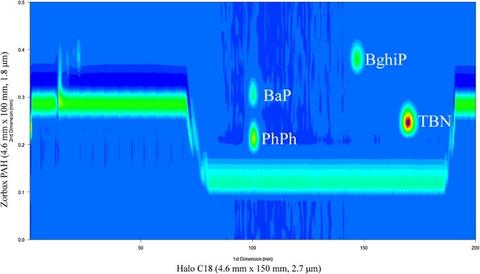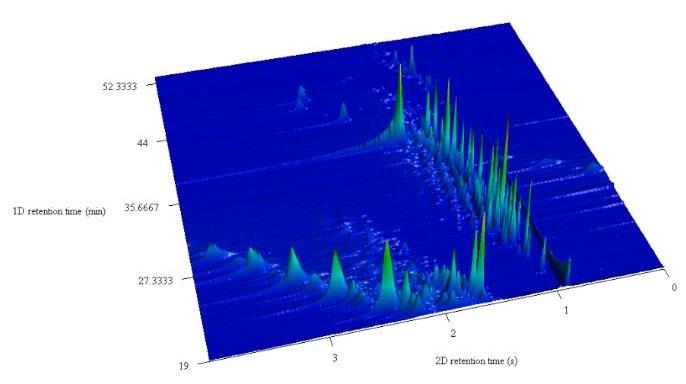Summary
Both comprehensive two-dimensional gas chromatography (GCxGC) and comprehensive two-dimensional liquid chromatography (LCxLC) have emerged as powerful tools capable of increasing the peak capacity of a single chromatographic analysis. Utilizing orthogonal chromatographic systems, analytes can be separated by two different, sequential retention mechanisms; this process allows for analytes to be separated from other compounds that would normally co-elute in a single dimensional separation. Efforts at NIST are being directed toward the study of issues related to quantitation by both GCxGC and LCxLC, value assignment of complex matrix Standard Reference Materials (SRMs), and non-targeted analysis.
Description

The development of robust analytical methods remains one of the most important (and costly) parts of chemical metrology. The separation of targeted constituents from other components in a sample matrix is necessary for accurate and precise measurements. Multidimensional chromatography is an important analytical tool since it provides high chromatographic resolution. The Chemical Sciences Division has used SRMs to thoroughly evaluate the quantitative capabilities of both GCxGC and LCxLC and examine the parameters that impact quantitation such as peak description, integration, data processing and experimental parameters. In addition to the investigation on the quantitative capabilities of two-dimensional chromatography, researchers at NIST have studied the qualitative strengths of the instrumentation, including non-targeted analysis. Non-targeted screening is an emerging analytical technique where previously unknown compounds can be identified through a combination of chromatographic and mass spectra data. Currently, GCxGC and LCxLC methods are being developed for the non-targeted screening of environmental, food, and nutritional supplement samples.
Major Accomplishments
- Qualitative assessment of SRM 1950 Metabolites in Human Plasma using GCxGC with different extraction and derivatization methods.
- Validated the quantitation performance of multidimensional chromatography for analytes in complex matrices (e.g., SRM 1597a Complex Mixture of PAHs from Coal Tar, SRM 2779 Gulf of Mexico Crude Oil, and SRM 869b Column Selectivity Test Mixture).
- Analysis of fatty acid methyl esters in petroleum diesel-biodiesel blends using GCxGC.
- Polyphenolic fingerprinting of dietary supplements by LCxLC with spectrophotometric and mass spectrometric detection (LCxLC-UV/Vis-MS).
- Non-targeted analyses of SRM 2585 Organic Contaminants in House Dust and marine mammal extracts (on-going).
Additional Technical Details
Large amounts of data is generated using GCxGC and LCxLC, especially when coupled to mass spectrometry. Hence data management and data analysis is crucial when using these techniques. Data analysis tools such as peak finding, spectral deconvolution, blank subtraction, and use of computational scripts to search for characteristic mass spectra fragmentations (both commercial and in-house written programs) are used.

ASSOCIATED PUBLICATIONS
- Striegel, A. M., "Size-Exclusion Chromatography: A Twenty-First Century Perspective," Chromatographia, 85, 307-313 (2022).
- Wise, S. A., Rodgers, R. P., Reddy, C. M., Nelson, R. K., Kujawinski, E. B., Wade, T. L., Campiglia, A. D., and Liu, Z. F., "Advances in Chemical Analysis of Oil Spills Since the Deepwater Horizon Disaster," Critical Reviews in Analytical Chemistry, (2022).
- Hayes, H. V., Wilson, W. B., Sander, L. C., Wise, S. A., and Campiglia, A. D., "Determination of PAHs in Combustion-Related Samples via Multidimensional Chromatographic Methods," Lc Gc North America, 37, 872-877 (2019).
- Matheson, A. and Striegel, A., "Sizing Up Size-Exclusion Chromatography (Part 2)," Lc Gc Europe, 32, 611-614 (2019).
- Piotrowski, P. and Place, B., "Comparison of Pre-Processing and Variable Selection Strategies in Group-Based GCxGC-TOFMS Analysis," Separations, 6, (2019).
- Place, B. J., Morris, M. J., Phillips, M. M., Sander, L. C., and Rimmer, C. A., "Evaluation of the impact of peak description on the quantitative capabilities of comprehensive two-dimensional liquid chromatography," Journal of Chromatography A, 1368, 107-115 (2014).
- Murray, J. A., "Qualitative and quantitative approaches in comprehensive two-dimensional gas chromatography," Journal of Chromatography A, 1261, 58-68 (2012).
- Brownthomas, J. M., Moustafa, A. A., Wise, S. A., and May, W. E., "Determination of Fat-Soluble Vitamins in Oil Matrices by Multidimensional High-Performance Liquid-Chromatography," Analytical Chemistry, 60, 1929-1933 (1988).

